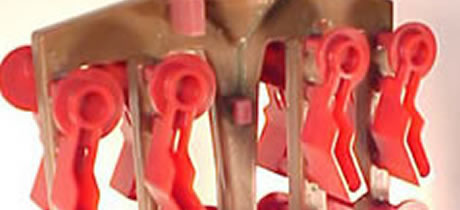 Click Here!
We're Here to Help!
Click Here!
We're Here to Help!
Investment casting is one of the oldest known metal-forming techniques. From 5,000 years ago, when beeswax formed the pattern, to today's high-technology waxes, refractory materials and specialist alloys, this process allows the production of components with accuracy, repeatability, versatility and integrity in a variety of metals and high-performance alloys.

The process is generally used for small castings, but has been used to produce larger parts too. It is generally more expensive per unit than die casting or sand casting, but has lower equipment costs. It can produce complicated shapes that would be difficult or impossible with die casting, yet like that process, it requires little surface finishing and only minor machining.
The term "investment" may bring dollar signs before the eyes of those who are not familiar with the process. Actually, it refers to the ceramic materials that are used to build a hollow shell into which molten metal is poured to make the castings. Wax is injected into an aluminum die to produce a pattern that is an exact replica of the part to be produced. For every casting, a wax pattern must be manufactured. The patterns are then clustered around a wax sprue and repeatedly dipped in to a vat of ceramic slurry and allowed to dry. After a shell thickness of approximately 3/8" has been built; the molds are de-waxed by either flash firing at high heat (1400° F) or autoclaving (pressure and steam). The hollow shells are then preheated to 1800-2000° F depending on the alloy to be poured and the molten metal is poured immediately into the hot shell. After cooling, the ceramic is vibrated and blasted off the metal parts and discarded. The balance of the cleaning operations (cut-off, grinding, heat treatment, straightening, blasting) are straight forward and quite similar to other casting processes.
Among the most commonly poured alloys: